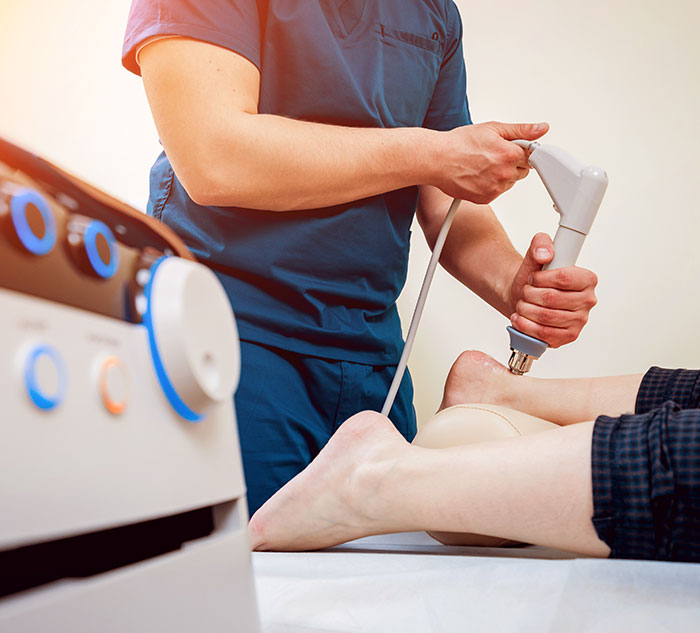The BIOS Orthopedic Institute
Alberto J. Panero, D.O.
Regenerative Orthopedics Specialist & Sports Medicine Specialist located in Sacramento, CA
Shockwave therapy is an FDA-approved treatment that involves the delivery of shock waves to your injured tissue to reduce pain and stimulate healing. Dr. Alberto J. Panero uses a shockwave therapy machine, the system transmits energy to the applicator that generates shockwaves. Make an appointment to come to The BIOS Orthopedic Institute in Sacramento, California to experience this state-of-the-art diagnostic tool today.
What is Shockwave Therapy
Also known as extracorporeal shockwave therapy (ECST), shockwave therapy is an FDA-approved treatment that involves the delivery of shock waves to your injured tissue to reduce pain and stimulate healing. It can also be referred to as Extracorporeal Pulse Activation Technology (EPAT)
Using a shockwave therapy machine, the system transmits energy to the applicator that generates shockwaves. Your therapist can adjust the frequency and pressure of those waves, depending on your condition.
Conditions Treated
- Shoulder – calcific tendonitis of rotator cuff muscles
- Elbow – golfers and tennis elbow
- Back pain – in the lumbar and cervical spine regions
- Hip – bursitis
- Knee – patellar tendonitis, Arthritis
- Upper leg – Iliotibial band friction syndrome
- Lower leg – shin splints
- Feet – plantar fasciitis, heels spurs, and Achilles tendonitis
Can Shockwave be combined with Orthobiologics like Platelet Rich Plasma (PRP) OR Bone Marrow Concentrate?
To further increase the efficacy of shockwave, many physicians will also combine EPAT technology with additional non-invasive solutions like platelet-rich plasma (PRP) therapy and ultrasound imaging. Be sure to ask your physician about his or her treatment approach.
Exploring the Type of Extracorporeal Shockwave Therapy (ESWT)
Some biological effects produced by shockwaves include regenerative changes at a cellular, tissue, and organ level. The two primary forms of shockwave are focused shock wave therapy and radial pressure wave therapy.
A focused shockwave initially produces a wide field of pressure wave, which becomes focused as it reaches a targeted depth and area within the body (the focus area). In the devices specifically for clinical use, there are three categories of focused shockwave, including electrohydraulic, electromagnetic, and piezoelectric.
By comparison, the radial device produces pressure waves where the force is exerted with maximum pressure at the applicator and weakens as waves travel deeper. Radial pressure waves are known for generating lower peak pressures.
The effectiveness of radial pressure wave vs. focused shockwave has been well studied for conditions including tendinopathy and spasticity. And both forms have been found efficacious and appropriate, but differences may result in varying outcomes for a specific condition. Results suggest that both forms of shockwave therapy are beneficial, but differences in effects may result in varying outcomes for a given condition.
Mechanisms of Action
Multiple clinical studies have shown ESWT effective in treating musculoskeletal conditions, but the exact mechanisms remain unclear. Proposed cellular mechanisms of action for extracorporeal shockwave therapy include:
- Increased collagen synthesis
- Cellular proliferation and wound healing
- Pain reduction
- Neovascularization
- Decrease in soft tissue calcifications
- Reduction of inflammation
Treatment Parameters to Consider
Depending on the diagnosis, the clinical treatment protocol may include a combination of instrumental parameters.
- Depth of focus dependent on targeted pathology
- Treatment with Radial Pressure Wave or Focused Shockwave or a Combination
- Treatment interval: 1 x per week
- The total number of treatments on average is between 3-5
- Anesthesia is not needed
- For clinical focusing, image guidance is recommended
- Number of impulses and impulse frequency
- Maximal positive pressure reached, measured in bar
- Energy Flux Density (EFD)
- Total Energy Dose (EFD)
References
https://www.curamedix.com/epat-extracorporeal-pulse-activation-technology


